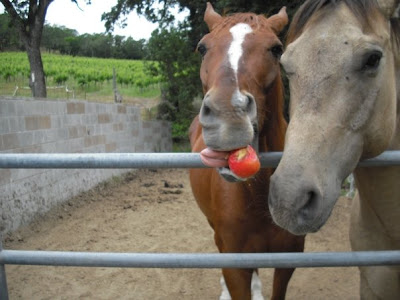 (photo by The Second Race, two residents of GEVA in Northern California)
(photo by The Second Race, two residents of GEVA in Northern California)Before I started The Second Race and went out on my own to rescue/retire ex-racehorses, I served on two boards of California based rescues. I learned from those that started their own, how difficult and the amount of work it takes to successfully get them up off the ground. I volunteer presently for CERF (California Equine Retirement Foundation) and see 25 years of experience in running a well organized and funded operation. Whether you are just contemplating a non profit, struggle each day to make it work, or have a relatively well known and funded group. It's a lot of work. Often folks go into rescue with the thought that they have a pasture area, pipe stalls and a willing heart, however many well intentioned (and some not so much) find it's not "easy" to open up a rescue facility for horses.
The Second Race does have it on the business plan to open it's own facility within five years. So I am learning and gathering resources all the time. I have discovered that the AAEP has put together a manual as a guide for those that would like to responsibly consider the creation of an equine rescue.
The introduction page from the manual reads:
In order to provide guidance to non-veterinarians at equine rescue and retirement
facilities regarding the care of a horse throughout its life, the AAEP has developed
the following care guidelines. Rescue and retirement facilities play a vital role in
providing lifelong care and/or finding new owners for horses that may be considered
“unwanted” or have been subjected to neglect or abuse. The AAEP recognizes and
commends the important services these facilities provide to the horses and individuals who benefit from their work. While many principles of basic horse care and management apply to all horses, regardless of their situation, those horses entering rescue or retirement facilities may arrive with unique health challenges. For this reason, employees and volunteers should be experienced in basic horse care and understand the health conditions that require medical attention from a veterinarian. Equine veterinarians play an important role in the care of the animals at rescue and retirement facilities and can offer valuable advice on many aspects of horse care. It is important that facilities establish a good relationship with an equine veterinarian. The guidelines presented in this manual are for informational use only and are not considered to be legally binding. Because appropriate horse care practices vary due to climate, region, use and many other factors, the guidelines are intentionally broad.
To read more or to download the manual here is the link:
http://www.aaep.org/pdfs/rescue_retirement_guidelines.pdf




No comments:
Post a Comment